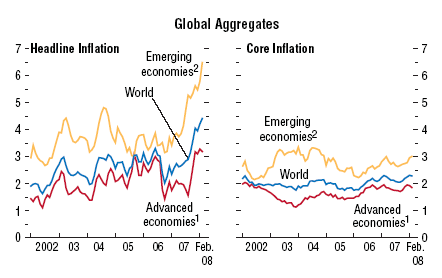The latest communiqué from IMF’s World Economic Outlook (WEO), released Friday – stressed IMF’s view of a significantly slower pace in global growth during the second half of fiscal ’08, before a gradual recovery starts to take place in fiscal ’09.
“The global economy is in a tough spot”, the fund said in its latest update – “caught between sharply slowing demand in many advanced economies and rising inflation everywhere, notably in emerging and developing economies”.

As a result of soaring commodity prices, inflationary pressures are clearly increasing at a faster pace in the emerging and developing economies. As inflationary pressures increase and gain a broader base, the impact of increased restraints for productive economic activity – accelerates. This economic deterioration inevitably leads to slower demand while presenting significant downside risks to economic growth.
The fund’s inflation forecasts for the emerging and developing economies was raised by more than 1.5 percentage points in both 2008 and 2009, to 9.1 percent and 7.4 percent, respectively.
However, apart from the fact of inflationary pressures gaining steam from accommodative macroeconomic, loose monetary policies and other factors, one aspect worth noting is that – the global fundamentals, aren’t all that bad. Despite the negativities the global economy has faced lately, IMF proceeded to raise its global economic-growth forecast for ’08 to 4.1% from an earlier estimate of 3.7% in April. The overall emerging and developing economies were also revised up 0.2 percentage point to 6.9% this year, with a 0.1-percentage-point increase over the April forecast for next year to 6.7%.
Additionally, China’s economy continues to expand at 10% clip. Brazil and Russia are also keeping a steady economic pace while India is estimated to grow 8% this year, up from an earlier forecast of 7.9%. Even the sluggish U.S economy had its growth estimate, in fiscal ’09, revised up to 0.8% from 0.6%. The point is, (without diminishing the economic impact from rising inflationary pressures) as global growth keeps running above 4%, any slowdown in demand, whether it is the U.S or the Western economies – will quickly be soaked up elsewhere.
The IMF’s April forecasts, particularly those for the U.S. and the European Union drew criticism from those countries’ governments including the World Bank, as being overly pessimistic (the IMF raised its EU area forecast, to 1.7% this year from its previous estimate of 1.4%).
IMF’s World Economic Outlook (WEO) stated that it sees risks to the global growth outlook as ‘balanced’.
- Bulenox: Get 45% to 91% OFF ... Use Discount Code: UNO
- Risk Our Money Not Yours | Get 50% to 90% OFF ... Use Discount Code: MMBVBKSM
Disclaimer: This page contains affiliate links. If you choose to make a purchase after clicking a link, we may receive a commission at no additional cost to you. Thank you for your support!


Leave a Reply